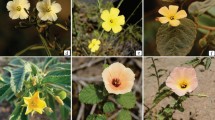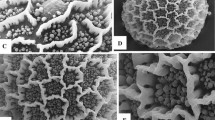Abstract
We document distyly in Damnacanthus (Rubiaceae) and investigate pollen morphology in the genus. Within nine taxa in Japan (four species, four varieties and one form), five show distyly. Non-distylous taxa of Damnacanthus always have a long style and short stamens. We examined the pollen morphology of all taxa of Damnacanthus in Japan. The pollen grains of Damnacanthus are 3- to 5-orthocolporate or sometimes loxocolporate. Polymorphic pollen is sometimes observed even within a single flower. Pollen dimorphism is associated with distyly; pollen grains from short-styled (thrum) flowers are significantly larger than those from long-styled (pin) flowers, and the muri are smooth in pin flowers whereas the pollen grains of thrum flowers have minute granules on the top and/or on the sides. In non-distylous taxa, in which the style is longer than stamens, the muri are always provided with minute granules. Interestingly, the pollen grains with granules in the non-distylous taxa contrast with the pollen of the distylous taxa, because granulate pollen grains are found only in thrum flowers. Although Damnacanthus is a stenopalynous genus, the number of colpi is useful for delimiting taxa. Based on palynological characters, we conclude that Damnacanthus should be revised.






Similar content being viewed by others
References
Andersson L, Rova JHE (1999) The rps16 intron and the phylogeny of the Rubioideae (Rubiaceae). Plant Syst Evol 214:161–186
Bahadur B (1968) Heterostyly in Rubiaceae. J Osmania Univ, Golden Jubilee Vol pp 207–238
Bahadur B, Laxmi SB, Swamy NR (1984) Pollen morphology and heterostyly: a systematic and critical account. Adv Pollen Spore Res 12:79–126
Baker HG (1953) Dimorphism and monomorphism in the Plumbaginaceae. Ann Bot 17:433–445
Baker HG (1956) Pollen dimorphism in the Rubiaceae. Evolution 10:23–31
Baker HG (1958) Studies in the reproductive biology of West African Rubiaceae. J West Afr Sci Assoc 4:9–24
Barret SCH, Richards JH (1990) Heterostyly in tropical plants. Mem N Y Bot Gard 55:35–61
Bremekamp CEB (1963) On pollen dimorphism in heterostylous Psychotrieae, especially in the genus Mapouria Aubl. Grana Palyn 4:53–63
Chinnappa CC (1981) Palynology and systematics of the genus Coffea. J Coffee Res 11:55–69
Chinnappa CC, Warner BG (1981) Pollen morphology in the genus Coffea (Rubiaceae) and its taxonomic significance. Bot J Linn Soc 83:221–236
Chinnappa CC, Warner BG (1982) Pollen morphology in the genus Coffea (Rubiaceae). II. Pollen polymorphism. Grana 21:29–37
Darwin C (1877) The different forms of flowers on plants of the same species. Murray, London
Dulberger R (1975) Intermorph structural differences between stigmatic papillae and pollen grains in relation to incompatibility in Plumbaginaceae. Proc R Soc Lond B 188:257–274
Dulberger R (1992) Floral polymorphisms and their functional significance in the heterostylous syndrome. In: Barrett SCH (ed) Evolution and function of heterostyly. Springer, Berlin Heidelberg New York, pp 41–84
Erdtman G (1960) The acetolysis method. A revised method. Svensk Bot Tidskr 54:561–564
Ganders FR (1979) The biology of heterostyly. N Z J Bot 17:607–635
Johansson JT (1987) Pollen morphology of the tribe Morindeae (Rubiaceae). Grana 26:134–150
Jung-Mendaçolli SL, Melhem TS (1995) Grãos de pólen deespécies heterostílicas de Rubiaceae. Rev Brasil Bot 18:61–98
Kanjilal UN, Das A, Kanjilal PC, De RN (1939) Flora of Assam, vol 3. p 80
Köhler E (1976) Pollen dimorphism and heterostyly in the genus Waltheria L. (Sterculiaceae). In: Ferguson IK, Muller J (eds) The evolutionary significance of the exine. Academic Press, New York, pp 147–161
Liao JC (1976) Genus Damnacanthus in Taiwan. Bull Exp For Natl Taiwan Univ 117:133–136
Lo HS (1979) A revision of the genus Damnacanthus Gaertn. f. from China (in Chinese). Acta Phytotaxon Sinica 17:104–109
Müller F (1869) Über eine dimorphe Faramea. Bot Z 27:606–611
Nakai T (1922) Trees and shrubs indigenous in Japan proper, vol.1 (in Japanese). Gamopetalae or Metachlamiydeae. Seibido, Tokyo, pp 405–413
Ping L, Johnston MO (2001) Comparative floral morphometrics of distyly in three evolutionary lineages of Amsinckia (Boraginaceae). Can J Bot 79:1332–1348
Punt W, Blackmore S, Nilsson S, Thomas AL (1994) Glossary of pollen and spore terminology. LPP Contributions Series No.1. LPP Foundation, Laboratory of Palaeobotany and Palynology, University of Utrecht, The Netherlands
Robbrecht E (1982) Pollen morphology of the tribes Anthospermeae and Paederieae (Rubiaceae) in relation to taxonomy. Bull Jard Bot Natl Belg 52:349–366
Robbrecht E (1988) Tropical woody Rubiaceae. Opera Bot 1:1–271
Robbrecht E, Puff C, Igersheim A (1991) The genera Mitchella and Damnacanthus: evidence for their close alliance; comments on the campylotropy in the Rubiaceae and circumscription of the Morindeae. Blumea 35:307–345
Ruan YZ (1999) Damnacanthus. In: Chen WC (ed) Flora of China, vol 71, part 2 (in Chinese). Science Press, Beijing, pp 167–176, 320–321
Vuilleumier BS (1967) The origin and evolutionary development of heterostyly in the angiosperms. Evolution 21:210–226
Walker JW, Doyle JA (1975) The bases of angiosperm phylogeny: palynology. Ann Mo Bot Gard 62:664–723
Yamazaki T (1987) The genus Damnacanthus in Japan, Korea and Taiwan (in Japanese). J Phytogeogr Taxon 35:69–74
Yamazaki T (1993) Damnacanthus. In: Iwatsuki K, Yamazaki T, Boufford DE, Ohba H (eds) Flora of Japan, vol 3a. pp 224–225
Author information
Authors and Affiliations
Corresponding author
Rights and permissions
About this article
Cite this article
Naiki, A., Nagamasu, H. Distyly and pollen dimorphism in Damnacanthus (Rubiaceae). J Plant Res 116, 105–113 (2003). https://doi.org/10.1007/s10265-002-0075-1
Received:
Accepted:
Published:
Issue Date:
DOI: https://doi.org/10.1007/s10265-002-0075-1




